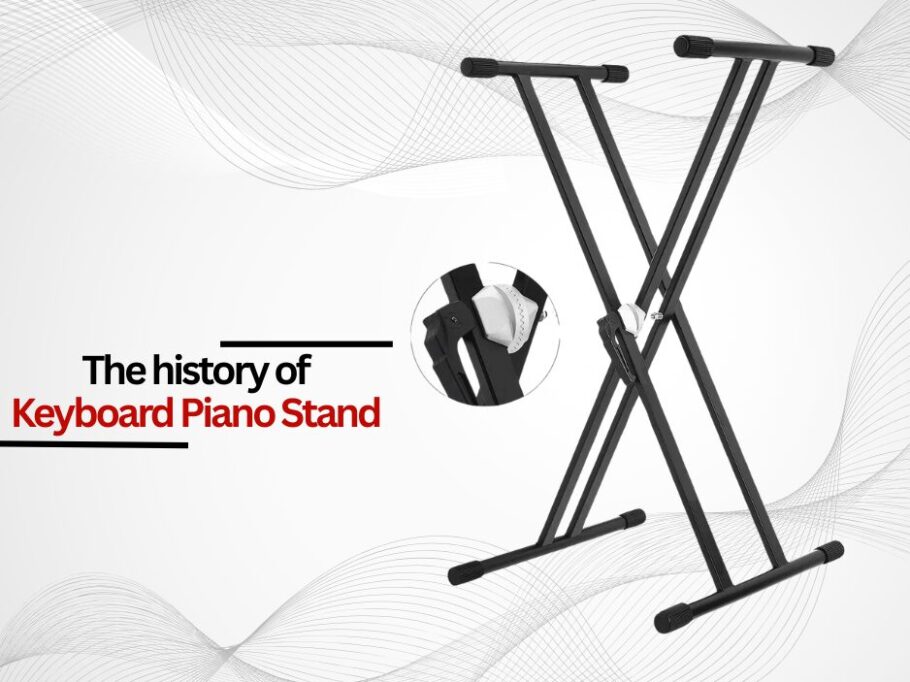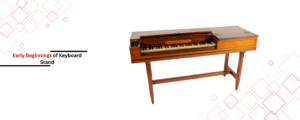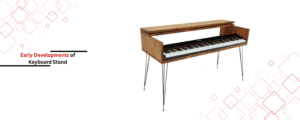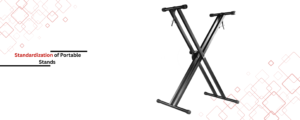Keyboard piano stands have always accompanied the evolution of music. In this article we analyze their development from the most primitive to modern multifunctional designs and the technology that accompanies them. We also look at the psychology of why some models are preferred over others.
To know more, read, Keyboard Stands and Benches in 2025: What’s Hot Right Now?
18th Century: The Beginning of Keyboard Instruments
Custom-made tables and furniture served as the first stands for keyboard instruments such as clavichords and harpsichords, which later evolved into early keyboard instruments. During this time, portable stands were not required as basic furniture designs had still not embraced the concept.
Similar furniture:
Household items such as writing desks and cabinets were used as ornamental furniture for keyboards. They were later turned into bulky ornamental cabinets, which is what these were designed to be. Design-wise, these were rather advanced, but not lightweight, which severely limited their portability.
Material Restrictions:
Design restrictions were related to the front only being decorated using “Baroque” or “Rococo” styling. The robust wood was used to make the partitions and the stands. Carving and wood lath along with these gave a sophisticated look. The height of the instrument was fixed and musicians had to work around that.
19th Century: The Early Development of Piano Stands
In the 19th century, the use of pianos surged, which deeply impacted the need for their supporting structures. With pianos gaining accessibility in middle-class households, there was a change from furniture-like structure to more tailored designs specifically meant for the piano.
The Evolution of “Custom-Made” Stands:
Serving as wooden chairs, crosstable frames specifically designed for lifting or holding sheet music were meant to serve as wooden chairs. These were often constructed by local craftsmen due to a lack of standardization of measurements.
Victorian Age Ornate Stands:
Wealthy families used to enjoy having access to fully carved, elaborate stands to match the decorative features of the pianos. These designs were decorated with brass, fancy inlay work, spun legs and spun legs. Little thought was given to the ergonomic design, which led to a lack of practicality.
The 20th Century: Standardization of Portable Stands
The development of electronic keyboards in the mid-20th century improved the design of computer stands. Stands became popular with musicians who performed from different locations because they were lightweight and easy to carry.
The Invention of X Stands:
The invention of the double-braced X-stand in the 1960s marked a significant milestone. It was easily foldable and could be adjusted into different positions, which provided both stability and ease of movement for traveling musicians.
New Materials:
Wood in the older models was replaced by steel and aluminum because they were light yet sturdy. Rubberized padding and telescopic legs were added to better height adjustments and prevent movement.
Brand Dominance:
With the advancement of ergonomics, companies began concentrating their designs on modular multifunctional stands along with their individual pieces to better suit their market. This opened up doors for contemporary ergonomic modular design systems.
The 21st Century: Customizable And Ergonomic Features
Use in home studios, live performances, and hybrid setups require modern stands to be adaptable. New materials and engineering redesigned them into advanced peripherals.
Z-Stands & Multi-Tier Stands:
The keyboard multi-tiered stand was created to facilitate the layering of tablets, MIDI controllers, and synthesizers. Also, Z-style stands became popular because of their sturdier support for heavier equipment.
Smart Integration:
The latest designs of these accessories incorporate modern aesthetics and advanced ergonomic contours along with built-in cable management, USB ports, and modular tablet or light mounts. No-dial adjustments to height and angles are now precision engineered without the need for tools.
Increasing Attention Towards Ergonomics:
Memory presets, anti-fatigue mats, and adjustable lumbar support demonstrate the shift towards ergonomic discomfort; the prevalence of musculoskeletal disorders tangles with long practice hours.
Conclusion
Just like music has progressed over the years, the keyboard stand also changed from a piece of furniture to more advanced ergonomic structures. Brands such as On Stage, Roland, 5 Core, and Donner have emerged as the leaders in the industry, each tailoring their advancements to the keyboard stand as a vital accessory. As instruments continue to blend with digital and acoustic systems, we can be certain they will change in ways we currently cannot predict. Regardless, their fundamental intent has stayed the same: to support the instrument while giving ease and comfort to the musician.





